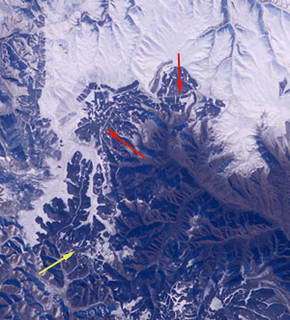China's Wall Less Great in View from Space

It has become a space-based myth. The Great Wall of China, frequently billed as the only man-made object visible from space, generally isn't, at least to the unaided eye in low Earth orbit. It certainly isn't visible from the Moon.
You can, though, see a lot of other results of human activity.
The visible wall theory was shaken after China's own astronaut, Yang Liwei, said he couldn’t see the historic structure. There was even talk about rewriting textbooks that espouse the theory, a formidable task in the Earth’s most populous nation.
Image: This photo of central Inner Mongolia, about 200 miles north of Beijing, was taken on Nov. 24, 2004, from the International Space Station. The yellow arrow points to an estimated location of 42.5N 117.4E where the wall is visible. The red arrows point to other visible sections of the wall. Credit: NASA.
The issue surfaced again after photos taken by Leroy Chiao from the International Space Station were determined to show small sections of the wall in Inner Mongolia about 200 miles north of Beijing.
Taken with a 180mm lens and a digital camera last Nov. 24, it was the first confirmed photo of the wall. A subsequent Chiao photo, taken Feb. 20 with a 400mm lens, may also show the wall.
The photos by Chiao, commander and NASA ISS science officer of the 10th Station crew, were greeted with relief and rejoicing by the Chinese. One was displayed prominently in the nation's newspapers. Chiao himself said he didn't see the wall, and wasn't sure if the picture showed it.
Kamlesh P. Lulla, NASA's chief scientist for Earth observation at Johnson Space Center in Houston, directs observation science activities from the Space Shuttle and the International Space Station. He says that generally the Great Wall is hard to see and hard to photograph, because the material from which it is made is about the same color and texture as the area surrounding it.
"The interpretation of this (Nov. 24) ISS photo," Lulla said, "seems to be good. It appears that the right set of conditions must have occurred for this photograph to capture the small segment of the wall." It was a sunny day and a recent snowfall had helped make the wall more visible.
The theory that the wall could be seen from the Moon dates back to at least 1938. It was repeated and grew until astronauts landed on the lunar surface.
"The only thing you can see from the Moon is a beautiful sphere, mostly white, some blue and patches of yellow, and every once in a while some green vegetation," said Alan Bean, Apollo 12 astronaut. "No man-made object is visible at this scale."
From space you can see a lot of things people have made, Lulla said. Perhaps most visible from low Earth orbit are cities at night. Cities can be seen during the day too, as can major roadways and bridges, airports, dams and reservoirs.
Of the wall visibility theories, Lulla said: "A lot has been said and written about how visible the wall is. In fact, it is very, very difficult to distinguish the Great Wall of China in astronaut photography, because the materials that were used in the wall are similar in color and texture to the materials of the land surrounding the wall -- the dirt."
It's questionable whether you can see it with the unaided eye from space. "The shape, the age of the structure, the resolution of the camera, the condition of the atmosphere -- all these factors affect the ability to detect an object from space." But, he added, "you can see the wall in radar images taken from space."
Source: NASA (by John Ira Petty)
















